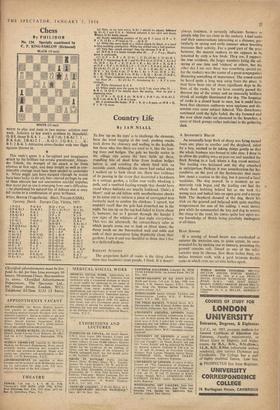Chess
By PHILIDOR No. 134. Specially contributed by
C. P. KING-FARLOW (Richmond) BLACK (10 men)
WHITE (12 men)
WHITE to play and mate in two moves: solution next week. Solution to last week's problem by Mansfield: Q-B 8, threat B-K 4. 1 . . . B-B 7 ch; 2 B-Kt 7. 1 . .. B-K 8 eh; 2 B-Kt 2. 1 . .. K-Q 3; 2 Q-R 6. 1 .. , K-
B 5; 2 B-K 5. Attractive cross-checker with two flight squares thrown in. * This week's game is a far-sighted and imaginative attack by the brilliant but erratic grandmaster, Alexan- der Tolush; the strength of the attack is far from obvious at first sight, and deep insight as well as con- siderable courage must have been needed to undertake it. White might just have escaped (though he would have been lucky to do so), but-moved perhaps by one of these obscure but not uncommon suicidal impulses that occur just as one is emerging from one's difficulties -he abandoned his natural line of defence and at once fell victim to a combination of great brilliance.
White, BaRTOK (Yugoslavia). Black, TOLUSH (USSR). Opening, Dutch. Europa Cup, Vienna, 1957.
1 P-Q 4 P-KB4 20Q x P(e) P-B 5!
2 P-K Kt 3 Kt-K B 3 21 Kt x Kt P (f) I) x Kt 3 B-Kt 2 P-K 3 22 Q x 13 P-B 6 4 K Kt-B 3 B-K 2 23 P x P P x P
5 0-0 0-0 24 B-12 1 Q-B 4 (g)
6 P-Kt 3 P-Q Kt 3 25 Kt-K 3 0-R 6 7 Kt-K 5 P-B 3 26 R-Q 4 K Kt-Kt 5
8 P-Q II 4 (a) B-Kt 2 27 Kt x Kt Kt X Kt
9 11-R 3 B x B 28R x Kt ch Q x R 10 Kt x B P-Q 3 29Qx BP R-K 7
1 I Kt-Q 3 P-K 4! (b) 30 (3 x Kt P Q- K 5
12 Kt-B 2 0 Kt-Q 2 31 C)-R 5 (h) R-B 4 13 Q-B 1 Q-B 2 32 Q-Q 8 ch K-Kt 2 14 Q-Kt 2 Q R-K 1 33 Q-() 7 eh K-Kt 3
15 P x P P x P 34 Q-Q 6 ch K-Kt 2
16 0 R-Q I P-K 5 35 Q-1(.14? (0 R x 13 Pi 17 Kt-B 4 Kt-K 4 36 Q-B 3 ch K-Kt 3
18 Q-R 3 (c) P-K Kt 4! 37 R-K 1 (/) R-K 7
19 Kt-R 3 Q-Kt 2! (d) 38 K-11 I P-I3 7!! (A) 39 Resigns
(a) Here, or on next move, 51-Kt 2 should he played, followed by Kt-Q 2 and P-K 4. Method adopted is too slow and leaves White's Q Kt badly pieced.
(5) Neatly exploiting position of Kt on R 3, since 12 P x F, P x P; 13 Kt x P? loses to 13 Q-K 21 (r) While this move leads to a violent attack by Black, it is hard to find anything satisfactory: White has drifted into a bad position. (4) Very fine-much stronger than the obvious P-K R 3.
(e) 20 P-K B 4 is better though after 20 ... P x P e.p.; Black's game is preferable.
(1) 21 P x P, P x P; 22 Kt x P. Kt (3)-Kt 5;'23 Kt-R 5, Q-Q B 2! threatening R-R I and Kt-B 6 eh or 23 P-K 3, Kt-B 6 eh; 24 13 x Kt, P x B; 25 K-R 1. K x Kt; 26 P x R, Q-R 3 or 21 P x P. P x P; 22 P-B 3, 11 x 1'; 23 P x P. P-B 4; 24 K-R 1, Kt (3)-Kt. 5!; 25 Q x P (25 P x Kt. B x B ch), Kt is R P!; 26 K is Kt, Q-Kt 6 ch; 27 K-Ks 1, Kt is P ch; 28 R x Kt. B X R; 29 R-Q R-IC 8 ch; 31) Kt x R,Q x K1 eh; 31 H-B I,
Q x R. These variations show the force of Black's attack.
(g) Here 24 . . . Kt (3)-Kt 5!, threatening Kt x K P is even stronger.
(h) White threatened R-K 8. (I) White might save the game by Q-Q 7 ch, since after 33 .. . R-B 2; 34 Q-Q S he should draw the ending. Now he gets a shattering blow. (J) 37 R is R, Q-K 8 ch; 38 R-B 1, P-B 7 ch; 39 K-Kt 2, Q-K 5 ch; 40 K-R 3, R-R 4 mate. (k) A problem-like finish: 39 R x R, Q is 11) mate, or 39 B is Q, P is Its.Q mate.










































 Previous page
Previous page